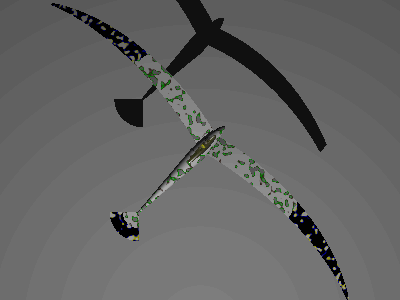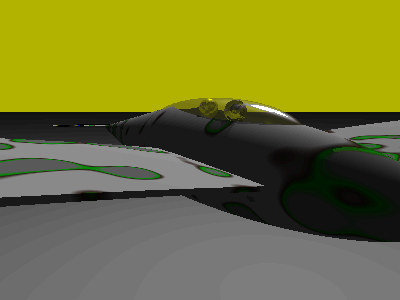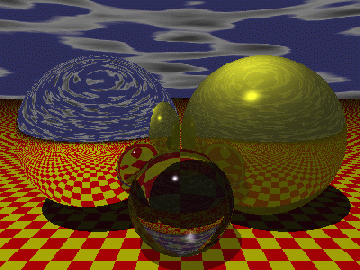![[LinuxFocus Image]](../../common/March1998/border-short.jpg)
| News Archives Companies Tips |
Beginning with Povrayby Antonio Castro |
Introduction
Some features of Povray
Getting Povray
Installing
Set up
POV
|
This article begins a series about the Povray raytracer. The purpose of the current article is to help novice Linux users to get started with POV-Ray. Persistence of Vision Ray-Tracer (POV-Ray) Copyright 1996 POV-Team. Introduction.Povray (Persistence of Vision Raytracer) is basically a ray tracer. It is hard to explain what this term means without getting into a number of details so let us leave a detailed explanation of what a ray tracer is for future articles. For the moment it suffices to sketch the concept of raytracing: It is a technique to render imaginary scences defined in the computer through the use of models, which declare the existence of objects and their shapes, as well as points, light sources and a camera. The computer tries to render an image as reallisticaly as possible while mantaining a minimum processing time.When possible POV-Ray tries to imitate nature. Sometimes POV-Ray has to settle for just imitating or simulating a natural effect. Without such shortcuts it would be impossible to render an image in a reasonable amount of time. Raytracing algorithms work by computing a large amount of rays (like light beams), however these rays do not behave like real optical rays. In nature, rays originate in light sources, move in space and whenever they encounter a physical obstacle (i.e a surface) they scatter, generating a new ray that goes from the point on impact to the retina's viewer or the camera's film. On the other hand, in a raytracer rays move backwards, from the viewer or film to the objects and then back to the light sources. We will leave a detailed explanation as to why and how of this algorithm for the next article. The quality of Povray is excellent and is comparable to most commercial raytracers. Commercial design products based on raytracing do have integrated tools for designing confortably all sort of objects. In the case of Povray, it is possible to use modellers from different independent companies or format filters, and in general the user has a great variety of tools available. This does not mean that it is impossible to achieve a beautiful or even fantastic design using exclusively Povray. Imagination is all that is required. Another important point is that the source code is public, allowing us to examine the various techniques used. Povray's copyright is described in Appendix A of the manual, as Linux it is a freeware licence. Check out the details in the original licence. There is a Povray manual available in a text version (easy for fast browsing), in HTML and postscript formats. If you think to print out the postscript file, you should prepare about 600 sheets; huge because of the great possibilities of Povray, but do not feel intimidated. In the present article you will be able to try out Povray and in next articles we will learn basic concepts. Povray lets us enter the world of infography through the front door, all thanks to its wonderful technical capabilities. My concept of infography is based on the notion that although pure technique can help us to obtain images with high realism, nevertheless artistic value does not equal realism nor technique itself. Technology is a valuable assistance, but everything that has real artistic value has to be conceived in our minds first. The idea is the main goal. Many times I like to play with the concepts of realism and fantasy.
Infography allows us to play this game of one and a thousand shapes
creating an interesting conflict in the viewer. http://slug.ctv.es/~acastro/infograf/catalog.htm Here is an example, a hybrid design: an airplane, a sailing ship and a seagull.
In this first image we can see more likely a seagull.
However, from a second perspective you can say that it resembles more an airplane while it is still the same object. The object has the silhoulette of a seagull. In the upper part, it has a transparent cockpit and two pilots are easily visible. The pigmentation is strange but with the raytracing these pictures can achieve a degree of astonishing realism. If you show these pictures to a 5-year old child, and ask him what he sees, he will likely answer that it is a photo, not a drawing. Showing the same pictures to an adult, he would have some difficulties to classify it. He will say that it is clearly neither a drawing nor a photo. Maybe he will know that was produced by a computer, but how can a machine can create this strange and beautiful scene? This kind of effect is the one I seek in my designs. Conflicting images where synthetic and artificial are put together in harmony with several realistic features. For it you need without a doubt imagination and a good knowledge of the technique. On the other hand, to get very realistic images, you should have a complete control over the technique, but maybe this can not be necessarely called art. I have truly spent many very good times with Povray and I'm sure that anyone that gets to know it will enjoy it the same. Some of the most important features of Povray
How to obtain PovrayPovray can be obtained by ftp.The official site where you can get it, is the following: http://www.povray.org
There is also an electronic magazine about povray, however, it looks abandoned, it keeps some good issues that first appeared when the Povray 3.0 was released. http://www.povray.org/pub/povray/ezine
There are lots of MIRRORS but none of them are official.
Index: (15-Enero-1998) ftp.povray.org Here, we enclose a short listing of the contents of the official site.
Linux users will be specially interested in two directories: 'pub/povray/Official-3.0/Linux' and 'pub/povray/Hall-Of-Fame' In latter we will find what we can not find in the great Povray handbook: Examples. The Povray handbook is really good but an image is better than thousand words. First the handbook is not illustrated in the proper way. And second in the other directory we can find several images that are an ideal complement for the handbook. I'm not saying that the handbook hasn't got enough examples, on the contrary it shows many. Every example explains a concept, and it is all right to acquire technical knowledge. Some handbook's examples are very beautiful, but 'Hall-Of-Fame' contains a selection of the best images ever created: a real infografic gallery. Every picture has attached a text explaining the tools and techniques used to obtain the incredible result. We have to be aware that many of the tools mentioned (in the handbook) as modellers, filters, etc. as a general rule are not available for Linux yet. We advise to download ftp.povray.org/pub/povray/Official-3.0/Linux and also ftp.povray.org/pub/povray/Hall-Of-Fame not only to enjoy the pictures, but as an important starting point for designing. We will describe how to execute a typical installation (it should work
in every Linux version, but it has been only completely tested with Debian).
InstallingAs it is usual in installations, we have to log in as super user (root).Let us assume that we have the distribution in the directory: "/incoming/pub/povray/Official-3.0/Linux" Then type in the following commands
You only have to check if the execution permissions are set for everybody in every directory in /usr/local/apli/povray/povray3 and for the x-povray and s-povray executables. In our case, we needed to change these permissions with 'chmod 755 (directory or file)'. SetupPovray setup process is useful to make accessible the "include" files library, to configure the graphics card, to define input and output file formats and many other features.Instead of explaining questions that are very well detailed in the handbook (Quick start), we will consider a generic configuration that will allow Linux users to use Povray in an easy, comfortable and immediate way. Povray can display in SVGA mode but this is a card-dependent issue. We will consider that you have an installation with Xwindows and using as image displayer 'xv'. The Linux configuration in the newer versions of povray can be simplified. It is possible to use environment variables, but it is more practical to create a config file *.ini with all you need. There are several *.ini sample files for general purposes. This provides several possibilities to set up the configuration. It is possible to refer our default configuration file in a environment file, or to use variables to locate the default include library, etc.. It also could be a good idea to pass as arguments a number of options, but we pass almost everything in a configuration file (*.ini) that at the same time we will specify as an argument of the command line. If you do not like this method, check out the handbook and you will see that there are several options to obtain the same result, however it is not a question for an introductory article to detail each option, but only the most useful. There is also a shell script for generating the images corresponding to all the examples 'allscene.sh'. Maybe instead of generating all the scenes with a low resolution, you would like to choose one and render it with the highest resolution. In this case, go to the example directory and execute povray using the following 'ini' file: -------------------------8<------------(ini.ini)---------------- Width=640 Height=480 Quality=8 Library_Path=/usr/local/apli/povray/povray3/include Output_to_File=on Output_File_Type=t Output_File_Name=out.tga verbose=on -------------------------8<--------------------------------------The first two lines will determine the resolution of the final image. The command to obtain the image is: $ s-povray ini.ini +i source.pov The file 'source.pov' is the name of the file that we would like to process, obtaining an image 'out.tga' that we can display with, for example, 'xv out.tga'. POV: a utility to work with Povray'pov' is a shell-script for using POV-ray easily. First we will show its listing:------------------------8<-----------------------------------
#!/bin/bash
#####################################################################
# Autor: Antonio Castro Snurmacher (1.998)
#
# pov (ver 1.0)
#
# Esta versión esta dedicada a su inclusión en la
# revista LinuxFocus (freeware)
#
# Este programa puede ser utilizado, distribuido, y modificado
# libremente pero siempre se deberá respetar la propiedad
# intelectual de su autor. Esta cabecera debe ser conservada
# tal cual en todas las modificaciones.
#
# En caso de traducción deberá conservarse el texto original de
# esta cabecera y añadirse la traducción a continuación de ella.
#
# El autor renuncia a todo tipo de beneficio económico y no se hace
# responsable de los posibles perjuicios derivados del uso del mismo.
#
# E-mail (acastro@ctv.es)
#
#####################################################################
# Author: Antonio Castro Snurmacher (1.998)
#
# pov (ver 1.0)
#
# This version has been written to be included in
# the LinuxFocus magazine (freeware)
#
# This program can be used, distributed, and modified
# freely but always has to respect the intellectual
# property of the author. This header should be kept
# untouched in every modification.
#
# In case of translation the text of this header should be kept
# and the translation will be added after it.
#
# The author renounces to any kind of economic benefit
# and he is not responsible for any damage derived from
# the use of this script.
#
# E-mail (acastro@ctv.es)
#
#####################################################################
usage(){
echo "Usage: pov (project) (size=0..6) (quality=1..11)"
echo
echo "0) 40x30 (STD/20) No backup"
echo "1) 80x60 (STD/10) No backup"
echo "2) 100x75 (STD/8) No backup"
echo "3) 200x150 (STD/4)"
echo "4) 266x200 (STD/3)"
echo "5) 320x200 *"
echo "6) 400x300 (STD/2)"
echo "7) 640x480 *"
echo "8) 800x600 * (STD)"
echo "9) 1024x768 *"
echo
echo "The projects should be located in the directory pointed by"
echo "${HOMEPOV} and will use the same name for it and for"
echo "the main source file *.pov"
echo "(STD) is the standard resolution chosen."
echo
exit 1
}
newversion(){
mv ${PREFIX}.pov.8.gz ${PREFIX}.pov.9.gz 2> /dev/null
mv ${PREFIX}.pov.7.gz ${PREFIX}.pov.8.gz 2> /dev/null
mv ${PREFIX}.pov.6.gz ${PREFIX}.pov.7.gz 2> /dev/null
mv ${PREFIX}.pov.5.gz ${PREFIX}.pov.6.gz 2> /dev/null
mv ${PREFIX}.pov.4.gz ${PREFIX}.pov.5.gz 2> /dev/null
mv ${PREFIX}.pov.3 ${PREFIX}.pov.4 2> /dev/null
mv ${PREFIX}.pov.2 ${PREFIX}.pov.3 2> /dev/null
mv ${PREFIX}.pov.1 ${PREFIX}.pov.2 2> /dev/null
cp ${PREFIX}.pov ${PREFIX}.pov.1
gzip ${PREFIX}.pov.4 2> /dev/null
}
#################################################
size(){
export SAVE="yes"
case $1 in
0) Width=40 ; Height=30; SAVE="no" ;;
1) Width=80 ; Height=60 SAVE="no" ;;
2) Width=100; Height=75 SAVE="no" ;;
3) Width=200; Height=150;;
4) Width=266; Height=200;;
5) Width=320; Height=200;;
6) Width=400 ;Height=300;;
7) Width=640 ;Height=480;;
8) Width=800 ;Height=600;;
9) Width=1024;Height=768;;
*) usage
esac
}
quality(){
case $1 in
1) ;;
2) ;;
3) ;;
4) ;;
5) ;;
6) ;;
7) ;;
8) ;;
9) ;;
10) ;;
11) ;;
*) usage
esac
export Quality=$1
}
####################### main ##############################
export HOMEPOV=${HOME}/dat/pov
export PROYECT=$1
export PREFIX=${HOMEPOV}/${PROYECT}/${PROYECT}
if [ $# != 3 ]
then usage
fi
export POVRAY=/usr/local/apli/povray/povray3
size $2
quality $3
if [ $SAVE == "yes" ]
then newversion
fi
cat <<-FIN > ${PREFIX}.ini
Width=$Width
Height=$Height
Quality=$Quality
Library_Path=${POVRAY}/include
Input_File_Name=${PREFIX}.pov
Output_to_File=on
Output_File_Type=t
Output_File_Name=${PREFIX}.tga
verbose=on
Post_Scene_Command=xv ${PREFIX}.tga
FIN
# Output_File_Type=t
## Others hight performace options ##
# Antialias_Depth=3
# Antialias=On
# Antialias_Threshold=0.1
# Jitter_Amount=0.5
# Jitter=On
# Low priority, maybe I want to do other things.
nice -20 x-povray ${PREFIX}.ini
if [ $SAVE != "yes" ]
then echo "Warning !! There is no backup of this version."
fi
------------------------8<-----------------------------------
When we are designing, we often have to test ideas many times,
and we get closer to our ideal step by step.
To simplify the execution we are going to implement a shell-script that generates a *.ini file, executes Povray tracer and after that displays the result. We assume that we are working in the directory $HOME/dat/pov/(project name) and that the name of the main file is (project name.pov) This script generate files *.ini that usually are enough for most situations. It is oriented to a specific way of working, but if you prefer another, it is easy to change. This utility backups the last changes on the source files because very often we would like to revert to a previous version; after making many changes looking for different results, often we decide to go back to a previous design path. As we mentioned above, the creative process looks like brush painting, we decide step by step how to continue. If we execute the script with the lowest resolutions, it generates no backup copy nor new version number: low resolution is an uniteresting test. With this kind of tests, you can just get an idea on the relative positions of the objects. This is a personal way of working, very easy. If your are not familiar with Povray it will be a good starting methodology. Maybe later you would like to adapt this tool to your particular necessities. Some of the available resolutions are the same as the standards modes of some video resolutions. Others are fractions of the 800x600 resolution. Type in 'pov' without arguments to ge a short help menu. Create an appropriate directory structure to work with it within your $HOME directory and you will see how easy is to work from the first day. We will base our exercises in the use of this tool. However it is not necessary to use it, it will more comfortable for you. We will begin with a simple example to check that everything works: ------------------------8<-----------------------------------
#include "colors.inc"
#include "textures.inc"
#include "glass.inc"
// Author: Antonio Castro
// The camera will look towards the contact point
// of both spheres
camera {
location <0, 15, 35>
look_at <0, 10, 0>
}
// Source of white light
object {
light_source {
<20, 100, 50>
color White
}
}
// Sky with white clouds
object {
sphere { <0, 0, 0> 200000} // Great vault of heaven
texture {Blue_Sky scale <50000, 6000, 50000>} // We strecht the clouds
}
// Golden ball
sphere { <-10, 10, 0> 10
texture { Gold_Metal }
}
// Mirror ball
sphere { <10, 10, 0> 10
texture { Mirror }
}
// Glass ball
sphere { <0, 5, 10> 5
texture { T_Glass1 }
}
// Floor
// It is made with a great sphere that touches the center <0,0,0>
// but it could be implemented with a plane.
sphere {<0, -1000000, 0> 1000000
pigment {checker color Red color Yellow scale 2 } // Checker texture
}
------------------------8<-----------------------------------
Copy it in $HOME/dat/pov/sample1/sample1.pov
If it is necessary create first the correct directory structure. Then use the 'pov' utility provided in this article, executing it from a XWindows xterminal session with your user as login. $ pov sample1 4 9 You should launch 'xv' to display it. When you plan to implement your own scenes, we recommend to open another 'xterm' window with the text verion of the handbook in the 'vi' for example, in read only mode to search in a fast way the keywords of the language, consulting its syntax, and some example of its use.
|
Translated by David Escorial
This website is mantained by Miguel A Sepulveda.


